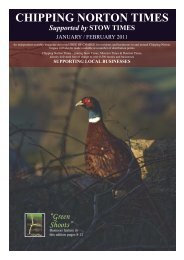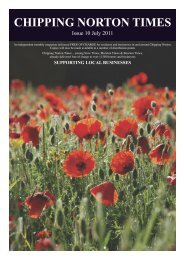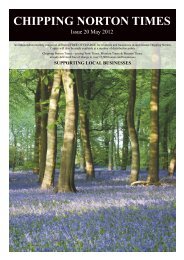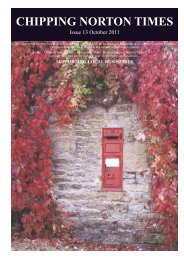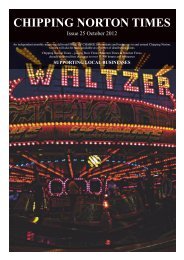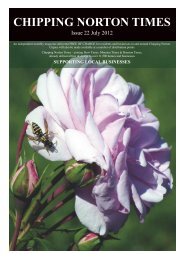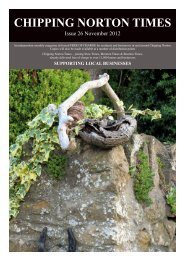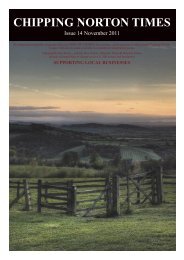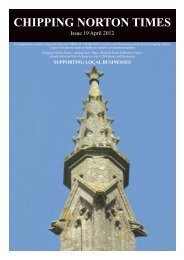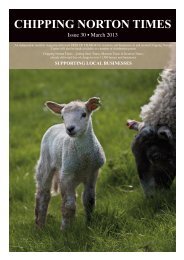Issue 24 - September 2012 (PDF) - Chipping Norton Times
Issue 24 - September 2012 (PDF) - Chipping Norton Times
Issue 24 - September 2012 (PDF) - Chipping Norton Times
You also want an ePaper? Increase the reach of your titles
YUMPU automatically turns print PDFs into web optimized ePapers that Google loves.
conservation is important, and sometimes we do need to make hard<br />
decisions. It’s just that these decisions need to be backed up by rigorous<br />
scientific research, and at the moment it seems, despite the claims of some,<br />
that research is exonerating raptors like the red kite, corvids (crows and<br />
magpies, for example) and grey squirrels from the large-scale declines in<br />
songbirds (never mind dogs and small children) that we have seen in recent<br />
decades. Our most destructive predator by far is the domestic cat, and the<br />
biggest drains on our birds’ numbers generally are cold, hunger and<br />
disease. I would argue that the most obvious downside to the return of the<br />
red kite is their potential to cause serious accidents on the M40 because they<br />
are so good at drawing our gaze away from the road!<br />
My sister in law is one of the many who are in awe of the beauty of red<br />
kites. At least she was until she discovered that they were carrion feeders,<br />
which seemed to tarnish their nobility in her eyes. I think this is harsh.<br />
Ihaveatendencytopolishoffmychildren’sleftoversatmealtimes,but<br />
don’t consider this overly damaging to my reputation – we all have our<br />
proclivities. Although they are renowned scavengers, kites will take live<br />
prey, from bird nestlings to small mammals like voles, rats and young<br />
rabbits. An important part of their diet, though, is earthworms, as it is<br />
for buzzards.<br />
The red kites’ return to our landscapes coincides with the expansion of the<br />
ranges of buzzards and ravens, birds which should have a considerable<br />
overlap in terms of their feeding ecology. This suggests that food is not, at<br />
this stage, a limiting resource. All are carrion specialists, particularly kites<br />
and ravens, which is one reason (but there are more fundamental ones) why<br />
they should not be vilified and victimised just because they are doing well<br />
at the moment. They are, in truth, rather poor hunters, and their predation<br />
levels on farmed pheasants are likely to be very low indeed. In the UK we<br />
host several wildlife conservation organisations that try hard to persuade<br />
people in other countries to protect and live alongside their wildlife (take<br />
tigers in India – which can actually kill people – or crop-raiding elephants<br />
in Africa and Asia) and yet we seem to be unable to live alongside creatures<br />
like otters, kites and buzzards in our own backyard.<br />
Let’s learn to practice what we preach. I hope that we will be able to<br />
appreciate this bird for what it is – a spectacular and natural part of our<br />
landscape and ecology, and a symbol of successful conservation measures<br />
of which we should be very proud.<br />
Red kites may exchange food in mid-air as<br />
part of their courtship<br />
All photographs © Mike Boyes<br />
If you are interested in volunteering to<br />
help wildlife in the Cotswolds, please<br />
contact me at:<br />
will.masefield@gloucestershirewildlife<br />
trust.co.uk, 07793 307056.<br />
Visit our Facebook page at<br />
www.facebook.com/gwtcotswolds.<br />
For wider volunteering opportunities,<br />
to become a member of Gloucestershire<br />
Wildlife Trust or to take part in our<br />
events throughout the year, visit<br />
www.gloucestershirewildlifetrust.co.uk<br />
or ring 01452 383333.<br />
13



